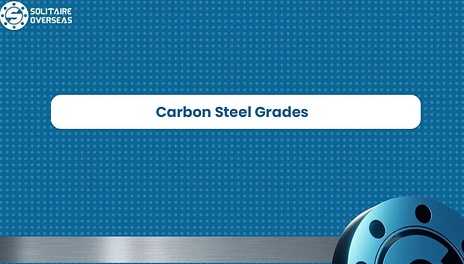Carbon Steel Grades

WHAT IS CARBON STEEL?
Steel, a strong and versatile material, owes much of its strength to the combination of iron and carbon. While pure iron lacks inherent strength and hardness, the infusion of carbon enhances these crucial properties, making steel a formidable building material.
The initial form of iron used in steel production carries a notable amount of carbon. In some instances, this carbon content can reach as high as 2.1%, marking the upper limit for a material to still be classified as steel.
Manipulating Carbon Content: Iron, the backbone of steel, can undergo further processing to adjust its carbon content. This manipulation plays a pivotal role in shaping various material properties, including:
1. Strength:
- Measured by yield point and tensile strength.
- Yield point denotes the stress at which a material deforms without breaking.
- Tensile strength signifies the stress required to cause a material to break.
2. Ductility:
- Measured by elongation, indicating the percentage increase in length before a material breaks.
- Defines a material’s ability to stretch without becoming brittle.
3. Hardness:
- Determines wear resistance and machinability.
- Typically assessed using the Rockwell or Brinell Hardness scale.
SA179 Tube specializes in providing a comprehensive range of carbon steel wire cloth and gratings. Our inventory includes various carbon steel grades such as 1018, A36, 1144, 12L14, A366/1008, A513, and 8620.
Types of Carbon Steel
Carbon Steel is categorized into four types based on the carbon content within the alloy. The varying carbon levels contribute to distinct properties and applications.
- Low Carbon Steel:
- Composition: 0.05%-0.25% carbon, up to 0.4% manganese.
- Also known as mild steel, it is a cost-effective material that is easily malleable.
- Carburizing can enhance surface hardness, though it is not as rigid as higher-carbon steels.
- Medium Carbon Steel:
- Composition: 0.29%-0.54% carbon, 0.60%-1.65% manganese.
- Exhibits ductility and strength with enduring properties.
- High Carbon Steel:
- Composition: 0.55%-0.95% carbon, 0.30%-0.90% manganese.
- Known for exceptional strength and shape memory, making it suitable for applications like springs and wire.
- Very High Carbon Steel:
- Composition: 0.96%-2.1% carbon.
- Extremely robust but requires special handling due to its brittleness.
Understanding the distinct characteristics of each carbon steel grade is crucial for selecting the right material based on specific project requirements. Whether it’s the versatility of low carbon steel or the strength of high carbon steel, SA179 Tube offers a diverse range to cater to various needs.
TYPE OF CARBON STEEL | CARBON COMPOSITION |
LOW CARBON/MILD | 0.05-0.25% |
MEDIUM CARBON | 0.26-0.60% |
HIGH CARBON | 0.61-1.50% |
A36 Mild Steel
ASTM A36 steel stands out as one of the most widely accessible hot-rolled steels in the market. It is commonly found in various forms, including square bars, rectangle bars, and diverse steel shapes such as I-Beams, H-beams, angles, and channels. The hot rolling process imparts a somewhat rough surface to this steel.
Noteworthy characteristics of ASTM A36 mild steel include:
- Yield Strength:
- A36 has a yield strength significantly lower than 1018 steel.
- This implies that A36 is more prone to bending, offering greater flexibility compared to 1018.
- Machinability:
- Machining A36 mild steel can be notably more challenging than working with 1018 steel.
- Despite the increased difficulty in machining, A36 is often chosen for its cost-effectiveness.
ASTM A36 Mild (low-carbon) Steel
| Minimum Properties | Ultimate Tensile Strength, psi | 58,000 – 79,800 |
| Yield Strength, psi | 36,300 | |
| Elongation | 20.0% | |
| Chemistry | Iron (Fe) | 99% |
| Carbon (C) | 0.26% | |
| Manganese (Mn) | 0.75% | |
| Copper (Cu) | 0.2% | |
| Phosphorus (P) | 0.04% max | |
| Sulfur (S) | 0.05% max |
1018 Mild Steel
Alloy 1018 stands out as the most commonly accessible among cold-rolled steels. Widely found in the market, it comes in various forms such as round rods, square bars, and rectangle bars. 1018 exhibits a well-balanced combination of typical steel traits, including strength, ductility, and ease of machining.
Key features of 1018 mild steel include:
- Versatility in Forms:
- Readily available in round rod, square bar, and rectangle bar forms, providing versatility for different applications.
- Mechanical Traits:
- Possesses a good combination of typical steel characteristics.
- Demonstrates strength, some ductility, and is comparably easy to machine.
- Chemical Similarity to A36:
- Chemically similar to A36 Hot Rolled steel.
- Despite this similarity, the cold rolling process imparts distinctive properties to 1018.
- Surface Finish:
- The cold rolling process contributes to a superior surface finish for 1018 mild steel.
- This enhances both the aesthetics and properties of the material.
| Minimum Properties | Ultimate Tensile Strength, psi | 115,000 |
| Yield Strength, psi | 100,000 | |
| Elongation | 8.0% | |
| Rockwell Hardness | B95 / C17 | |
| Chemistry | Iron (Fe) | 97.54 – 98.01% |
| Carbon (C) | 0.4 – 0.44% | |
| Manganese (Mn) | 1.35 – 1.65% | |
| Phosphorus (P) | 0.04% max | |
| Sulfur (S) | 0.24 – 0.33% |
1144 (Stressproof-equivalent) Steel
The 1144 steel, often regarded as Stressproof-equivalent, stands out as a fascinating material within the realm of steel. Offering higher strength compared to 1018 or A36, it also boasts improved ductility, making it a well-rounded alloy for various applications.
Key characteristics of 1144 steel include:
- Strength and Ductility:
- Exhibits higher strength than 1018 or A36.
- Features improved ductility, combining strength with flexibility.
- Low Distortion or Warpage:
- Chiefly known for its remarkable resistance to distortion or warpage after machining.
- This unique property arises from a combination of its chemistry, method of manufacture, and heat treatment.
- Machinability:
- 1144 steel is relatively easy to machine, making it a preferred choice for applications requiring intricate machining processes.
- Boasts a machinability rating of 83% of AISI 1212 steel.
| Minimum Properties | Ultimate Tensile Strength, psi | 115,000 |
| Yield Strength, psi | 100,000 | |
| Elongation | 8.0% | |
| Rockwell Hardness | B95 / C17 | |
| Chemistry | Iron (Fe) | 97.54 – 98.01% |
| Carbon (C) | 0.4 – 0.44% | |
| Manganese (Mn) | 1.35 – 1.65% | |
| Phosphorus (P) | 0.04% max | |
| Sulfur (S) | 0.24 – 0.33% |
12L14 Free Machining Steel
12L14, classified as free machining steel, is a specialized alloy that incorporates lead to significantly improve its machinability. Notably, it boasts an impressive machinability rating of 160% of AISI 1212 steel. While the addition of lead enhances its machining characteristics, it does come with trade-offs, particularly in terms of strength.
Key features of 12L14 free machining steel include:
- Lead for Machinability:
- Lead is intentionally added to enhance machinability.
- Achieves a high machinability rating of 160% compared to AISI 1212 steel.
- Strength Characteristics:
- Although the strength of 12L14 is reduced compared to non-leaded alloys like 1018, it generally maintains higher strength levels.
- Specialized Use:
- 12L14 is chosen for applications where excellent machinability is a critical factor.
- Commonly utilized in projects where intricate and precise machining processes are required.
| Minimum Properties | Ultimate Tensile Strength, psi | 78,300 |
| Yield Strength, psi | 60,200 | |
| Elongation | 10.0% | |
| Rockwell Hardness | B84 | |
| Chemistry | Iron (Fe) | 97.91 – 98.7% |
| Carbon (C) | 0.15% max | |
| Manganese (Mn) | 0.85 – 1.15% | |
| Phosphorus (P) | 0.04 – 0.09% | |
| Lead (Pb) | 0.15 – 0.35% | |
| Sulfur (S) | 0.26 – 0.35% |
A366/1008 Steel
A366/1008 steel is a type of alloy commonly employed for “commercial quality” cold-rolled steel sheet applications. Recognized for its excellent formability and relatively high strength, it is favored in various industrial settings. Notably, this alloy boasts a superior surface finish compared to hot-rolled A36 steel.
Key attributes of A366/1008 steel include:
- Formability:
- A366/1008 steel is renowned for its exceptional formability, making it well-suited for applications where shaping and bending are crucial.
- Strength:
- Exhibits comparatively high strength, providing structural integrity in various commercial uses.
- Surface Finish:
- Features a very good surface finish, surpassing the quality of hot-rolled A36 steel.
- The improved surface finish enhances both aesthetics and performance in applications where appearance matters.
- Cold-Rolled Process:
- Cold-rolled to achieve the desired properties, resulting in enhanced dimensional accuracy and surface quality.
| Minimum Properties | Ultimate Tensile Strength, psi | 43,900 – 51,900 |
| Yield Strength, psi | 26,100 – 34,800 | |
| Elongation | 42 – 48% | |
| Chemistry | Iron (Fe) | 99% |
| Carbon (C) | 0.08% | |
| Manganese (Mn) | 0.6% max | |
| Phosphorus (P) | 0.035% max | |
| Copper (Cu) | 0.2% min | |
| Sulfur (S) | 0.04% |
A513 (Alloy 1020-1026) Steel
A513 steel, specifically alloyed with 1020-1026, finds common application in the manufacturing of DOM (Drawn Over Mandrel) tubing. This alloy stands out for its higher carbon content, resulting in increased strength. However, it’s important to note that the higher carbon content comes with trade-offs, including lower weldability and machinability.
| ties | Ultimate Tensile Strength, psi | 87,000 |
| Yield Strength, psi | 72,000 | |
| Elongation | 10.0% | |
| Rockwell Hardness | B89 | |
| Chemistry | Iron (Fe) | 99.08 – 99.53% |
| Carbon (C) | 0.18 – 0.23% | |
| Manganese (Mn) | 0.3 – 0.6% | |
| Phosphorus (P) | 0.04% max | |
| Sulfur (S) | 0.05% max |
8620 Alloy Steel
8620 alloy steel is distinguished by its unique combination of a hard outer surface and a ductile interior, contributing to its higher strength. This material is favored in various industrial applications for its specific set of properties. However, it’s important to note that the higher carbon content comes with trade-offs, including lower weldability and machinability.
| Minimum Properties | Tensile Strength, psi | 97,000 |
| Yield, psi | 57,000 | |
| Brinell Hardness | 201 | |
| Elongation | 25% | |
| Machinability | 66% | |
| Chemistry | Carbon (C) | 0.18 – 0.23% |
| Manganese (Mn) | 0.7 – 0.9% | |
| Phosphorus (P) | 0.35% Max | |
| Sulphur (S) | 0.4% Max | |
| Silicon (Si) | 0.15 – 0.35% | |
| Chromium (Cr) | 0.4 – 0.6% | |
| Nickel (Ni) | 0.4 – 0.7% | |
| Molybdenum (Mo) | 0.15 – 0.25% max |
